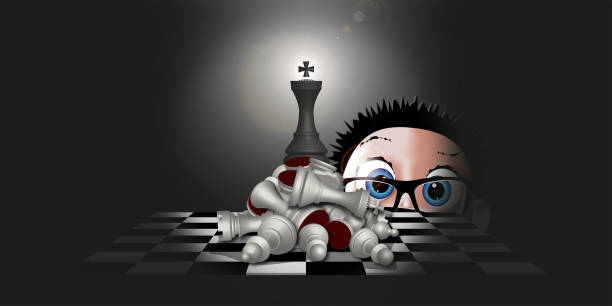The Hardest Computer Chess
Contents
In the realm of artificial intelligence and gaming, few challenges rival the intricacies and complexities of computer chess. Known as one of the most intellectually demanding games, computer chess pushes the boundaries of machine intelligence and human ingenuity. In this article, we delve into the depths of the hardest computer chess matches, exploring the technology behind them and the relentless pursuit of mastery in this digital battleground.
Understanding the Essence of Computer Chess
What Makes Chess So Challenging?
Chess, a game of strategy and foresight, presents players with an intricate web of possibilities and outcomes. Its seemingly simple rules give rise to an astronomical number of potential moves, leading to a vast and complex decision tree. The depth of analysis required to excel in chess is staggering, making it a true test of cognitive prowess.
For instance, consider a typical chess game. With each player having 20 legal moves on average at each turn, the number of possible positions after just two moves per side is approximately 400! This astronomical number underscores the immense computational challenge of mastering the game.
The Evolution of Computer Chess
Since the advent of computing, scientists and programmers have been fascinated by the prospect of teaching machines to play chess. The history of computer chess is punctuated by landmark achievements, from the early days of brute-force algorithms to the era of deep learning and neural networks. Each advancement has brought us closer to the elusive goal of creating a truly formidable chess-playing AI.
A notable example of this evolution is IBM’s Deep Blue, which made history in 1997 by defeating world champion Garry Kasparov in a highly publicized match. Deep Blue’s victory marked a watershed moment in the field of artificial intelligence, demonstrating the power of computational methods in tackling complex intellectual tasks.
The Quest for Supremacy: Battles of Titans
Deep Blue vs. Garry Kasparov: A Clash of Titans
One of the most iconic moments in the history of computer chess came in 1997, when IBM’s Deep Blue faced off against world champion Garry Kasparov. The match captivated the world as man and machine squared off in a battle of wits. In a stunning upset, Deep Blue emerged victorious, marking a pivotal moment in the annals of AI history.
The match between Deep Blue and Kasparov showcased the potential of computational methods in mastering complex strategic games. Deep Blue’s ability to analyze millions of positions per second allowed it to outmaneuver even the greatest human players, highlighting the power of brute-force algorithms in chess programming.
Stockfish vs. AlphaZero: The Dawn of Reinforcement Learning
In more recent years, the emergence of AlphaZero has reshaped the landscape of computer chess. Developed by DeepMind, AlphaZero employs a revolutionary approach to learning, eschewing traditional programming in favor of reinforcement learning. In a series of groundbreaking matches, AlphaZero demonstrated its superiority over Stockfish, one of the strongest traditional chess engines.
AlphaZero’s success against Stockfish marked a paradigm shift in chess programming, showcasing the potential of machine learning techniques in mastering complex games. By learning from scratch through self-play and reinforcement learning, AlphaZero was able to discover novel strategies and outperform traditional engines based on handcrafted heuristics.
The Inner Workings of Chess Engines
Brute Force and Beyond: The Algorithms Behind Chess Engines
At the heart of every chess engine lies a sophisticated algorithm designed to evaluate positions and select optimal moves. Early engines relied primarily on brute-force methods, exhaustively searching through millions of possible positions. However, modern engines leverage a combination of heuristics, machine learning, and domain-specific knowledge to navigate the complexities of the game.
For example, the minimax algorithm, coupled with alpha-beta pruning, forms the backbone of many chess engines. This algorithm allows engines to explore the game tree efficiently while discarding unpromising branches, enabling them to focus on the most promising lines of play.

The Role of Machine Learning in Chess
Machine learning plays a central role in the evolution of computer chess. By analyzing vast troves of game data and leveraging advanced neural networks, chess engines can uncover patterns and strategies that elude human players. This adaptive approach allows engines to continually refine their tactics and adapt to new challenges, pushing the boundaries of what is possible in the game of chess.
Deep learning techniques, such as convolutional neural networks (CNNs) and recurrent neural networks (RNNs), have revolutionized chess programming by enabling engines to learn directly from experience. By training on large datasets of expert games, these networks can extract valuable insights and improve their performance over time, demonstrating the power of data-driven approaches in AI development.

The Human Touch: Man vs. Machine
Embracing the Challenge: Humans Against AI
Despite the formidable prowess of modern chess engines, human players continue to hold their own against the machines. The allure of human creativity and intuition remains a potent force on the chessboard, challenging AI developers to push the limits of their algorithms further. In tournaments and exhibitions around the world, players pit their skills against the mightiest of engines, showcasing the enduring appeal of human-versus-machine battles.
Human ingenuity and intuition often complement the analytical power of chess engines, allowing players to devise creative strategies and outmaneuver their digital counterparts. While AI has undoubtedly transformed the landscape of competitive chess, human players remain an indispensable part of the game, embodying the spirit of innovation and resilience in the face of technological advancement.
The Future of Computer Chess
Towards New Horizons: The Quest for Perfection
As technology continues to advance, the future of computer chess holds boundless possibilities. From innovative algorithms to ever-expanding computational power, the pursuit of perfection in chess AI shows no signs of slowing down. With each passing day, we edge closer to unlocking the mysteries of the game, pushing the boundaries of human knowledge and machine intelligence alike.
Advancements in quantum computing, algorithmic efficiency, and machine learning promise to revolutionize the field of computer chess in the years to come. As AI continues to evolve and adapt, we can expect to see new breakthroughs and paradigm shifts that will further blur the line between human and machine intelligence, ushering in a new era of discovery and innovation in the world of chess.

Conclusion
In the ever-shifting landscape of artificial intelligence and gaming, computer chess stands as a beacon of innovation and challenge. From the early days of algorithmic brute force to the era of deep learning and neural networks, the hardest computer chess matches have captivated audiences and pushed the limits of human achievement.
As we look to the future, the quest for supremacy on the chessboard continues unabated, driving us towards new frontiers of technology and human ingenuity. In the end, the hardest computer chess remains not merely a game, but a testament to the boundless potential of the human mind and the machines we create.





